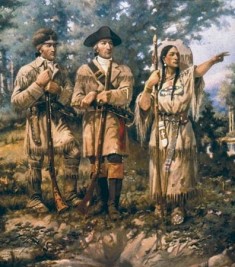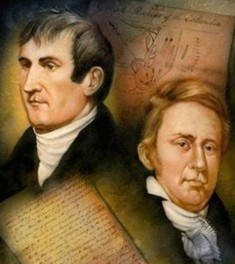| Lewis and Clark | |
|---|---|
 |
|
| Explorers | |
| Specialty | Exploration of western United States |
| Journey Start | May 1804 |
| Journey End | Sep. 1806 |
| Nationality | American |
Meriwether Lewis and William Clark are known as great American explorers. They hailed from neighboring counties in Virginia. Meriwether Lewis and William Clark were both serving the army and during their campaigns against British and the native Indians, they had developed a bond of enduring friendship with each other. Interestingly, Clark was Lewis’s commander in the initial days in the army.
Jefferson Hires Lewis and Clark
In 1801, Lewis was offered the role of secretary-aide by then-President Thomas Jefferson. Jefferson hired Lewis for his knowledge of the western part of the country as Jefferson probably had exploration of this territory already in his mind. Lewis worked closely in arrangements for the expedition, and as the funds were arranged in 1803, Jefferson appointed Lewis as the Leader of the expedition.
Lewis asked his friend and former commander, William Clark, to be the co-commander of this expedition. Clark accepted this offer and the duo were prepared to set out for this long campaign in May of 1804. This expedition was named Corps of Discovery Expedition, but is now popularly known as Lewis and Clark Expedition.
Reasons for the Expedition
Commissioned by President Thomas Jefferson, the primary objective of this expedition was to map and explore the newly acquired territory, to find a practical route for Western parts of the continent, and to establish an American presence in those parts before the British or other European countries tried to claim it.
The secondary objective of the campaign was more from scientific and economic perspective – to study the flora and fauna, animal life and geography of the region, and to establish trade and economic relationship with native Indians.
About the Expedition
 The expedition started the journey to the Pacific Coast from St. Louis via the Missouri River. It went through the areas that are covered by Kansas City, Missouri, Omaha and Nebraska. The team included 33 people.
The expedition started the journey to the Pacific Coast from St. Louis via the Missouri River. It went through the areas that are covered by Kansas City, Missouri, Omaha and Nebraska. The team included 33 people.
In August of 1804, the team lost their first man, Sergeant Charles Floyd, probably due to acute appendicitis. He was the only member of expedition to die during the journey. By the end of August, Lewis and Clark had reached the edge of the Great Plains.
During the expedition, Lewis and Clark met more than two dozen indigenous tribes and they built diplomatic relations with them. Without the help of these tribes, the expedition probably would have never been successful as they provided food and shelter during harsh winters and also guided them on to the best path, without which the team would have their way lost in Rocky Mountains.
With some tribes, such as the Sioux, the team faced problems. In fact, with the Sioux, there were concerns that the two sides would fight, but after many of disagreements and meetings, finally the two sides reached a settlement. In the winter of 1804-1805, the team camped near present-day Washburn, North Dakota, at Fort Mandan. While here, Lewis and Clark met several Indian tribes and studied their locations, water routes and trade practices.
In Fort Mandan, Lewis and Clark met Toussaint Charbonneau, who was a French-Canadian Fur trapper, and his Shoshone wife, Sacagawea. They helped the team by acting as translators and joined the expedition. Sacagawea later delivered a baby during the expedition and played an important role in negotiations with native tribes many a time. The expedition reached the Pacific Ocean in November of 1805. On March 23, 1806, they began the return journey. The crew returned back to St. Louis by September 23, 1806.
Results of the Expedition
The Lewis and Clark crew managed to meet the objective of reaching the Pacific Ocean, mapping and establishing a presence for legal claim to the land. They also managed to establish diplomatic relations with dozens of native tribes along the way. They could not find a continuous water route to the Pacific, but Lewis and Clark gained a better understanding of the geography of the area and they could produce pretty accurate maps of the region. They drew more than 140 maps during the expedition.
There were many scientific benefits from the mission as well. The expedition documented plants, animals, and natural resources of the region. The team recorded more than 200 new species of plants and animals and noted details of 72 native tribes. It was on this trip that Lewis and Clark saw a grizzly bear, which was a new discovery for science. The expedition also sent a prairie dog back to Thomas Jefferson.
Lewis and Clark’s Legacy
With their expedition, Lewis and Clark registered to become the first Americans to cross the Continental Divide and registered their name in the history books with their historic expedition. After the expedition, Jefferson appointed Lewis as governor of the new Louisiana territory, but he died soon after. Jefferson also appointed Clark as the Indian agent for the West.